Nutrients Availability in Quality Protein Maize (QPM) Cobs at Various Levels of Nitrogen Application
| Received 05 Apr, 2022 |
Accepted 21 Feb, 2023 |
Published 31 Mar, 2023 |
Background and Objective: The central core of a maize ear (maize cob) represents around 17% of the total biomass of a maize plant. In Sub-Saharan Africa, maize cobs are underutilized even though they are available to most farming households. The study aimed to estimate the proportion of nutrients in various genotypes of Quality Protein Maize (QPM) maize cobs and estimate the variability of these nutrients at different levels of nitrogen application. Materials and Methods: Thirty-two QPM inbred lines were evaluated in a randomized complete block design with two replicates at five nitrogen (N) application rates (0, 30, 60, 90 and 120N) in depleted soil under field conditions. The variances in nutrients estimated among genotypes were analyzed at various levels of treatments using SAS software and Tukey’s test was used for mean separation. Results: Highly significant differences were observed between N levels for all the nutrients estimated except fat, starch and potassium. The total digestible nutrient (TDN) in maize cobs was 76.19 with 1.64% of fat and 34.74% starch at all nitrogen levels. The nitrogen application rate of 30N provided 17% of crude protein, 20% crude fiber, 20% ash, 0.11% P, 0.2% Ca, 0.07% Mg, 180.63 mg kg‾1 of Fe and 16.44 mg kg‾1 of Mn. The QPM cobs of genotypes L1, L7, L11, L13, L16, L8, L19, L21 and L27 contained a low amount of Mn, Cu and Mg elements. Conclusion: As 30N application was most effective at the farmer level. The cobs of nine QPM hybrids could be used for animal feeding and mushroom production while the rest could be for soil amendments.
| Copyright © 2023 Liliane et al. This is an open-access article distributed under the Creative Commons Attribution License, which permits unrestricted use, distribution, and reproduction in any medium, provided the original work is properly cited. |
INTRODUCTION
Maize (Zea mays L.) is a major cereal crop that is grown worldwide. Maize cob is the central core of an ear and it is cheaply available as waste in some maize farmlands. Maize cobs account for about 17% of total maize biomass1. Maize residues such as cobs, husk and stover are usually burnt causing air pollution and soil degradation. They are also used for cooking or plough back in the field and in some cases, are just thrown away not only in Africa2,3 but also in Europe and Asia4,5. Thus, maize cobs can be efficiently used for different purposes.
In Sub-Saharan Africa, maize cobs are underutilized even though they are available to most farming households that grow the crop as their staple food. After harvesting maize, the cobs could be used in their intact form or ground into small particles6. Different approaches have been put in place to improve the utilization of maize cobs which include processing of maize cobs using chemicals, exogenous enzymes and through ensiling for practical animal feed formulation6. There are huge quantities of maize cobs which could be fed to ruminants instead of being wasted. Mierlită et al.7 found that an increase in the number of corn cobs to 50% in the diet of lambs resulted in a decrease of 14.57% of the concentrate intake needed to obtain a one kg weight increase. Moreover, the utilization of fermented corn cobs with various bio-activators as feed was able to increase feed consumption, body weight gain, dry matter digestibility and digestibility of organic matter and able to reduce feed conversion in sheep. Ndego et al.8 stated that the livestock feed formulation industry might benefit from the use of fermented maize cob with a 10% inoculum as a feed ingredient in animal feed formulations, as well as feed fortifier for improved protein. Also, the relatively low crude fiber content of maize cob compares to other by-products support its uses in animal feed. Maize cobs are also used as the substrate for mushroom production in different countries where mycelia can digest it to support the growth, development and fruiting of mushrooms9,10. Ali et al.11 found that biochar obtains from maize cobs is a good approach for improving maize physiology, soil enzyme activity, soil aggregate stability, microbial biomass carbon and nitrogen, organic carbon and soil quality. Anukam et al.12 found that maize cobs were suitable for gasification due to the low concentration of metallic elements and moisture content and also because they have manageable amounts of energy that could be converted into useful energy. Biochar from maize cobs is low-cost renewable energy and could replace platinum when used in microbial cells1. An alternative use of maize cob would be to produce particleboard panels in association with wood particles.
Maize cobs contained various nutrients. Woźniak et al.13 found that maize stover fraction (cobs, husks, leaves and stalks) influenced the chemical and structural parameters. Mature maize cobs have higher neutral detergent fibert (NDP), acid detergent fiber (ADF), dry matter (DM) and low crude protein (CP). Maize cobs contain a lot of cellulose and hemicellulose which can be used as an energy source feed for ruminants. Previous studies stated that the nutrient and chemical composition of maize cobs as crude protein was 30.2 g kg–1 of dry matter, ash was 45.3 g kg–1 of dry matter, neutral detergent fiber was 816.4 g kg–1 dry matter and other extracts being 7.5 g kg–1 dry matter6. Anukam et al.12 estimated the weight percentage of metallic component elements in maize cobs as 0.31 % of Al, 1.5.3% of K, 0.44% of Si, 1.32% of Na, 0.42% of Mg and 0.06% of Fe. Maize production is faced with different environmental constraints that cause poor yields, especially under small-scale farmers’ conditions. Additionally, continuous cropping over decades without taking any precautions to regenerate the soil’s productivity has contributed to decreased soil fertility which consequently leads to poor maize production14. In most cases, the problem is worsened by the lack of availability and/or high cost of mineral fertilizers that could be used for maize production. The objective of the present study was to estimate the proportion of nutrients in various genotypes of QPM cobs and estimate the variability of these nutrients at different levels of nitrogen application. An additional objective was to recommend the optimum rate of nitrogen fertilizer application for efficient and economic production of good quality maize cobs.
MATERIALS AND METHODS
Study area, plant materials and experimental site: Thirty-two white Quality Protein Maize (QPM) inbred lines sourced from CIMMYT-Zimbabwe and Quality Seeds (PTY) LTD South Africa, were evaluated during the 2017/2018 summer season (from 05/12/2017 to 16/06/2018) at the Crop Research Farm of the University of Fort Hare (UFH) in the Eastern Cape Province of South Africa for nitrogen use efficiency at five nitrogen levels (0, 30, 60, 90 and 120 kgNha–1).
The UFH Research farm (320°47'51"S and 270°50'55"E) is at an altitude of 508 m above sea level with a semi-arid climate, an average annual rainfall of 525 mm and an annual mean temperature of 18.1°C15. Before initiating the experiment, the soil was depleted of nutrients by planting unfertilized oats in high density during two successive winter seasons. Harvested oat crops and the entire residues were removed from the plot during the two winter seasons.
Treatments and experimental design: The experiment was arranged in a randomized complete block design (RCBD) with two replicates. Two seeds were sown per planting station and later thinned 2 weeks after sowing (WAS). Five nitrogen levels (0, 30, 60, 90 and 120 kgNha–1) were applied. The experimental plot consisted of a single row of 5 m long for each inbred line, with an inter-row distance of 0.75 m and 0.25 m between two consecutive planting stations. Seeds of each inbred line were sown at a depth of 3 to 5 cm.
The control, 0 kgNha–1 had no fertilizer applied throughout the study. However, basal fertilizer application using N:P:K ratio 2:3:4 (30 N) was done at a rate of 20 kgNha–1 at planting. The N fertilizer as LAN (46%) was applied three times for all of the three N treatments (60, 90 and 120 kgNha–1, respectively i.e., 1/3 apart at 4 WAS, 1/3 apart at 6 WAS and 1/3 apart at 8 weeks after sowing (WAS)).
Trial management: The trial management was done manually and chemically at the Research farm of Fort Hare University. Alachlor 384 EC was applied at the recommended rate of 4 L ha–1 at planting as a pre-emergent herbicide. The herbicides atrazine 500SC (active ingredient atrazine 500 g L–1) and Basagran (active ingredient bendioxide 480 g L–1) were applied every 2 weeks at a recommended rate of 2 ha–1 starting from 2 weeks after seed emergence till tasseling for the control of nutsedge grass in the experimental plots. Grass weeds were also removed by hand hoeing at 5 and 10 weeks after sowing (WAS). Grasshoppers and leaf hoppers were controlled using Dursban (Chloropyrifos 480 EC) applied at 1.5 L ha–1 (75mL/20Lt water). Cylam 50EC (active ingredient Lambda-cyhalothrin) (pyrethroid) was applied at a rate of 75 mL ha–1 for the control of cutworms (Agrotis segetum) seven days after emergence and 14 days after the first application. Cypermethrin 200EC was applied at a recommended rate of 120 mL ha–1 for maize stalk borer (Busseola fusca) control when signs of insect damage were noticed. The trials were largely rain-fed, though irrigation was applied to facilitate early and uniform crop establishment.
Nutrient determination: At physiological maturity, three plants per plot were harvested. Kernels were removed and the cobs were dried at 70°C for 48 hrs in an oven until they reached a constant weight. The cobs were then analyzed at Dohne Research Centre/Stutterheim in the Eastern Cape of South Africa, to determine the proportion of total N, crude protein, moisture, fat, crude fibre, ash and starch, including the other elements such as P, Ca, Mg, K, Cu, Fe, Mn and total digestible nutrients (TDN).
Statistical analysis: The mean squares of the different nutrients were estimated for genotypes at various levels of nitrogen application using SAS software version 9.2 and Turkey’s test was used for mean separation at the least significant level of 5%.
RESULTS AND DISCUSSION
Mean square variances of estimated nutrients: Crude protein, crude fiber, moisture, fat, starch, total nitrogen, ash, potassium (K), calcium (Ca), magnesium (Mg), phosphorus (P), total digestible nutrients (TDN), iron (Fe), manganese (Mn) and copper (Cu) are physicochemical properties and nutrients digestibility of maize cobs which have a direct bearing on gut fill, fermentation rate and overall digestion of animal diets6. The analysis of variances showed highly significant differences (p<0.01) observed between N levels for all the traits estimated except fat, starch and the general mean (expressed in percentage per mg of grounded maize cob) was 2.83 of crude protein, 5.71 of moisture, 1.64 of fat, 15.56 of crude fibre, 3.72 of ash, 34.74 of starch and 1.16 of total N (Table 1). Moreover, at various levels of N, highly significant differences were observed for different nutrients estimated except potassium and the general mean was 0.09% P, 0.13% Ca, 0.06% Mg, 0.64% K, 3.48% Cu, 191.41 mg kg–1 Fe, 167.52 mg kg–1 Mn and 76.19% TDN (Table 2).
| Table 1: | Mean squares of some elements (crude protein, moisture, fat, crude fiber, ash, starch and total nitrogen) in QPM cobs at various levels of nitrogen | |||
| Source (a) | DF |
Crude product |
Moist |
Fat |
Crude fiber |
ASH |
Starch |
Total N |
| N level | 4 |
86*** |
19*** |
0.41NS |
8.0*** |
0.8*** |
10.7NS |
0.08** |
| Replication | 1 |
133*** |
2.6NS |
4.6** |
31.9*** |
0.5* |
8.2NS |
0.4*** |
| Genotype | 31 |
4.5NS |
0.9NS |
0.4NS |
0.9NS |
0.09NS |
6.8NS |
0.03NS |
| N level×genotype | 124 |
5.6NS |
0.9NS |
0.5NS |
0.8NS |
0.1NS |
7.1NS |
0.03** |
| Error | 159 |
6.1 |
1.4 |
0.4 |
0.9 |
0.09 |
6.6 |
0.02 |
| Mean | 2.83 |
5.71 |
1.64 |
15.56 |
3.72 |
34.74 |
1.16 |
|
| Moist: Moisture, Total N: Total nitrogen, *p<0.05, **p<0.01, ***p<0.001 and NS: Non-significant | ||||||||
| Table 2: | Mean squares of different nutrients estimated in QPM cobs at various levels of nitrogen | |||
| Source (b) | DF |
P |
Ca |
Mg |
K |
Cu |
Fe |
Mn |
TDN |
| N level | 4 |
0.02*** |
0.3*** |
0.005** |
0.2NS |
213*** |
691741** |
7161255*** |
2.6*** |
| Replication | 1 |
0.2*** |
0.2* |
0.0002NS |
1.7NS |
2.7NS |
1873606*** |
9922*** |
3.5*** |
| Genotype | 31 |
0.003NS |
0.02NS |
0.01*** |
0.5NS |
34.7*** |
99472NS |
7133364*** |
0.08NS |
| N level×genotype | 124 |
0.004NS |
0.03NS |
0.01*** |
0.5NS |
35.9*** |
142779NS |
7121549*** |
0.07NS |
| Error | 159 |
0.003 |
0.04 |
0.001 |
0.6 |
9.6 |
160242 |
536 |
0.09 |
| Mean | 0.09 |
0.13 |
0.06 |
0.64 |
3.48 |
191.41 |
167.52 |
76.19 |
|
| P: Phosphorus, Ca: Calcium, Mg: Magnesium, K: Potassium, Na: Sodium, *p<0.05, **p< 0.01, ***p< 0.001 and NS: non-significant | |||||||||
However, no significant variation was observed among varieties for all traits except Mg, Cu and Mn which presented highly significant differences (p<0.001) with a general mean values of 0.06%, 3.48% and 167.52 mg kg–1, respectively (Table 2). The proportion of nutrients varied considerably at all levels of nitrogen application (0, 30, 60, 90 and 120N). The nutrient concentration did not vary much in maize cobs from one genotype to another. These results were similar to the findings of Rawal et al.16, who found that the average concentrations of N, P2O5 and K2O were 15.79, 9.56 and 3.77g kg–1 in grain and 6.74, 4.17 and 10.46g kg–1 in stover at maturity with the differentiation being base on the rate of NPK applied. Moreover, nitrogen and phosphorus were accumulated mostly in grain (68-83%), whereas potassium was observed more in stover (64-77%).
Proportion of all nutrients estimated at different levels of nitrogen application: The composition of maize cobs is affected by maturity stage, cultivar presence, agro-climatic conditions and production methods6,13. The crude protein varied from 1.02 at 0N application to 3.05 at 120N application while crude fiber ranged from 15.94 to 15.42 at 0N and 90N, respectively, ash ranged from 3.84 at 0N to 3.56 at 120N application and total N was found to varied from 1.14 to 1.21 at 0N and 120N application respectively (Table 3). At 30N application, the moisture content observed was 6.17% with the mean value at various N applications of 5.71%. The moisture content observed in the current study was close to the one found by Anukam et al.12 which was 5.1% in their study on the characterization of maize cobs for application in a gasification process for energy production. This value of moisture content is relatively low and could be good for gasification to take place leading to low smoking propensity during the combustion process. Ndego et al.8 stated that maize cobs is made up of 14.80-17.60% crude protein (CP), approximately 10% crude fiber and 3.4-6.40% crude ash. The total digestible nutrients varied from75.86 % at 0N to 76.32% at 120N with a value of 76.14% at 30N application (Table 4). The substantially low cob nutrient contents observed in the current study could be due to the type of maize genotypes used as well as the agricultural practices applied for maize production. However, the cobs of the QPM inbred lines still contained nutrients that could be for beneficial uses in agricultural systems. In addition, being able to predict feed intake when feeding bulky feeds is important since it is a guidance as to the correct concentration of nutrients in diets to ensure adequate intake for the animal.
Amounts of crude protein and total nitrogen at a different levels of nitrogen application: The highest quantity of total nitrogen was found at 120N (1.21) followed by 90N (1.19) while for crude protein, 60N had the highest proportion (3.89) as shown in Fig. 1. The crude protein content of a feed sample represents the total nitrogen (N) in the diet, which includes the true protein as well as the non-protein nitrogen and is required daily for animal maintenance, lactation, growth and reproduction17.
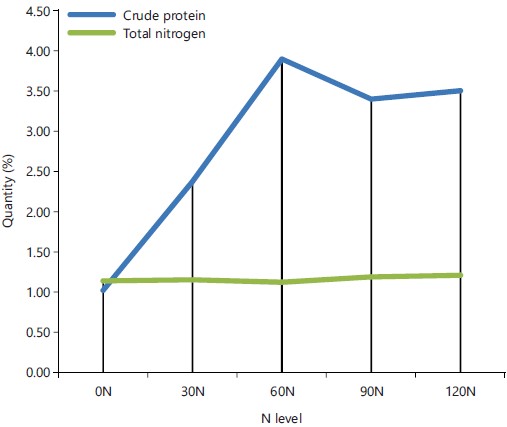
|
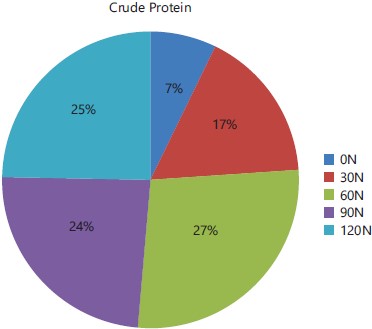
|
These two elements are very important in the formulation of animal feeds and their concentrations vary depending on the race of animal, the stage of development and the environmental condition of growth. Halvorson and Johnson18 found in their study that cob N concentration did not vary with fertilizer N rate averaging 3.51 g kg–1 overall N rates.
Percentage of crude fiber, ash, crude protein and total nitrogen at different levels of nitrogen application: In maize cobs, 27% of crude protein was observed at 60N whereas at 30N, 60N and 90N application, the proportion of total nitrogen found in maize cobs was the same (20%) as shown in (Fig. 2).
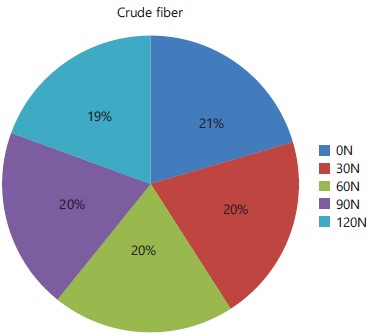
|
| Table 3: | Proportion of some elements (crude protein, moisture, fat, crude fibre, ash, starch and total nitrogen) in QPM cobs at different levels of nitrogen | |||
| N level (a) | Crude protein (%) |
Moisture (%) |
Fat (%) |
Crude fiber (%) |
ASH (%) |
Starch (%) |
Total nitrogen (%) |
| 0N | 1.02c |
5.61bc |
1.56a |
15.94a |
3.84a |
35.18a |
1.14c |
| 30N | 2.37b |
6.17ab |
1.71a |
15.90a |
3.80ab |
34.63a |
1.15b |
| 60N | 3.89a |
6.34a |
1.56a |
15.47ab |
3.69bc |
35.02a |
1.12a |
| 90N | 3.39ab |
5.01d |
1.72a |
15.42b |
3.71ab |
34.12a |
1.19ab |
| 120N | 3.50ab |
5.42cd |
1.69a |
15.10b |
3.56c |
34.75a |
1.21ab |
| Mean | 2.83 |
5.71 |
1.64 |
15.56 |
3.72 |
34.74 |
1.16 |
| N value represents the rate of nitrogen fertilizer application and means within each column followed by the same lowercase letter are not significantly different | |||||||
| Table 4: | Gross composition of solvent extracted processed soyabean based diets | |||
| N level (b) | TDN (total digestible nutrient) (%) |
P (%) |
Ca (%) |
Mg (%) |
K (%) |
Cu (mg kg–1) |
Fe (mg kg–1) |
Mn (mg kg–1) |
| 0N | 75.86c |
0.08c |
0.14a |
0.05b |
0.63a |
0.99c |
156.06b |
4.62d |
| 30N | 76.14b |
0.11a |
0.20a |
0.07ab |
0.61a |
3.33b |
180.63ab |
16.44c |
| 60N | 76.29a |
0.08c |
0.18a |
0.07ab |
0.67a |
3.03b |
362.08a |
30.69b |
| 90N | 76.33a |
0.10a |
0.11ab |
0.06b |
0.57a |
6.06a |
179.05ab |
20.19cb |
| 120N | 76.32a |
0.07c |
0.04b |
0.07a |
0.73a |
4.00b |
79.22b |
765.67a |
| Mean | 76.19 |
0.09 |
0.13 |
0.06 |
0.64 |
3.48 |
191.41 |
167.52 |
| N value represents the rate of nitrogen fertilizer application and mean values within each column followed by the same lowercase letter are not significantly different | ||||||||
The highest proportion of total nitrogen was observed at 120N application (21%). The lowest was found at 60N applications (19%). Wachirapakorn et al.19 found in their study that the total mixed ration of feed intake containing 14% of crude protein in the diet meets the protein requirement for lactating cows producing 11-13 kg milk/day. Therefore, the proportion of crude protein obtained at 30N fertilizer application (17%) could be the most appropriate and effective at the farmer level since it meets the requirement for stock feed without any additional ingredients.
The highest crude fiber and ash were observed at 0N application (21%) as expected (Fig. 3). The lowest was obtained at 120N (19%). The application of 30N, 60N and 90N provided the same amount of crude fiber and ash in maize cobs. It has been demonstrated that in the formulation of animal feed, when crude fiber content is higher, the energy content of the feed is lower because crude fiber is considered as being indigestible.
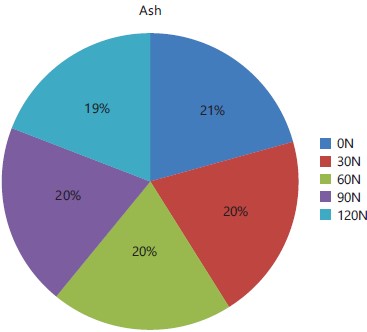
|
Kanengoni et al.6 stated that dietary fibers improved pig intestinal health by promoting the growth of lactic acid bacteria, which suppressed the proliferation of pathogenic bacteria in the intestines and this could be obtained by modifying the structure of the components in the fibrous maize cobs through grinding, heating and fermentation. In the present study, the crude fiber obtained at 30N application (20%) could economically be the best compared to the one found at 120N application (19%). It was found that fiber from distilled dried grains soluble in the ethanol production process is modified by grinding, heating and fermentation of the feedstock making it more digestible than fiber from maize cobs20,21. Therefore, allowing maize cobs through the fermentation process could increase the digestibility in an animal guns. In addition, mechanical processing, use of chemicals, exogenous enzymes and ensiling have been investigated to improve the digestibility of maize cobs6. Increasing dietary fiber in diets decreases the digestibility of nutrients and energy in pigs and sows. Although positive, the pelleting impact is minor on the energy and nutrient digestibility of fiber-rich diets in growing pigs, even in high-dietary fiber diets20.
Moreover, proper animal feeding and nutrition are crucial to the profitability of the livestock enterprise since overfeeding is wasteful and underfeeding decreases animal performance and profitability. Maize cobs are one of the potential feed ingredients that might be used to partially replace some ingredients in poultry feed. Its utilization in animal feed at relatively low concentrations would minimize the environmental pollution problem as well as reduce the cost of feeding20. Donkoh et al.22 used 24 g kg–1 of ash as dietary ingredients in broiler diets to achieve their target in poultry feeds. Moreover, Shareef et al.11 in their study on the characterization of biochar derived from maize straws and cobs found a high percentage of ash content (25.45% from straw and 20.45% from cobs) which improved the quality of biochar obtained. Therefore, the reprocessing of crop residues such as maize cobs into low-cost biochar can improve soil properties as well as plant growth thereby reducing the use of chemical fertilizers1,11. In the current study, the optimum proportion of ash as shown in (Fig. 4) was obtained in maize cobs at 30, 60 and 90N applications (20%). Ali et al.11 got an ash content value of 12.3% at 3.21% of moisture content which increased to 14.8% at 1.84% of moisture. In the present study, the ash content found was low because of the high moisture content. Nevertheless, 30N was the most appropriate and economical rate of fertilizer as the farmer applies less to get more.
The total nitrogen in maize cobs did not vary from 0 to 30N application whereas, at 60N application, there was a 1% reduction in N content as shown in (Fig. 5). The current observation could be due to the initial nitrogen status in the experimental soil environment. From 90 to 120N application, an increase of 1% in total nitrogen was observed in maize cobs.
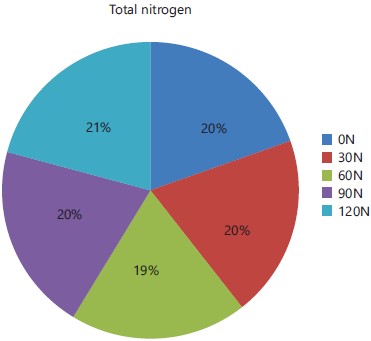
|
This result corroborated with the findings of Nenova et al.23 who stated that the increase in N fertilizer dose leads to the increase of nitrogen content in dry matter. Moreover, they found that maize cobs (0.71%) were the second highest storing nitrogen content after leaves (0.94%). In addition, Halvorson and Johnson18 found that cob yield generally increased with increasing N rate. Knowing that Nitrogen is the building block of proteins in feeds and forages, it is relevant to consider the cost of production of maize crops when choosing the appropriate amount of N fertilizer. The application of 30N could be the best in this case.
Essential macronutrients (P, Ca and Mg) and micronutrients (Mn and Fe) available in maize cobs at various levels of N application: Maize cobs contained high quantities of P (0.11%), Ca (0.2%) and acceptable amounts of Mg (0.07) at a 30N application rate compared to other levels of nitrogen application as shown in (Fig. 6a). These nutrients are important in the diet of animal feeds. Donkoh et al.22 studied on ground maize cob as a dietary ingredient and used 4.0 g kg–1 of Ca, 0.2 g kg–1 of P and 2.4 g kg–1 of Mg in their poultry feeding trial diets managed to get relatively good growth performance of the birds. In the current study, the amount of P, Ca and Mg in maize cobs obtained at 30N application could be efficiently used in animal feeds.
High concentrations of Mn were observed in maize cobs at 120N application (765.67 mg kg–1) with a high amount of Fe being observed at 60N (362.08 mg kg–1) as shown in (Fig. 6b). Christica and Julia24 concluded from their study that activated carbon from corn cob could decrease level of ferrous, copper and lead in industrial waste through the immobilization process. There is a health hazard associated with the consumption of maize with high concentrations of heavy metals25. In the current study, the nitrogen level application that gave acceptable and not harmful amounts of Fe and Mn in maize cobs could be 30N with 180.63 mg kg–1 of Fe and 16.44 mg kg–1 of Mn. Wienhold et al.26 reported that cob Ca, Mg, Zn, Fe, Mn and Cu content increased representing immobilization except K. Therefore, as cellulosic conversion technology becomes available, cobs represent a feedstock that can be harvested with a minor effect on crop nutrient availability.
Amount of macronutrient (Mg) and trace elements (Cu and Mn) in maize cobs among QPM genotypes evaluated: The genotypes L1, L26, L29 and L18 expressed relatively high amounts of Mg (0.24, 0.05, 0.07 and 0.04), Cu (3.03, 12.04, 8.01 and 2.76) and Mn (11.82, 23.48, 25.72 and 47.95) respectively in their cobs compared to other QPM genotypes (Fig. 7a-c).
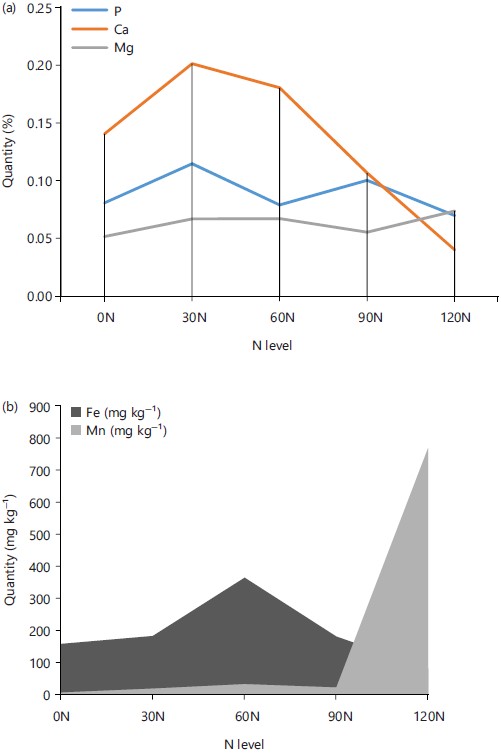
|
However, the genotypes L7 (0.05), L8 (0.05), L11 (0.05), L13 (0.05), L18 (0.04), L19 (0.05), L26 (0.05), L27 (0.05) and L32 (0.05) gave the lowest amount of Mg. Genotypes L1, L8, L16, L19, L20, L21, and L27 expressed a relatively low amount of Cu. All the genotypes showed a low amount of Mn except for L4 (24.76), L18 (47.95), L20 (23.80), L22 (24.93), L23 (24.59), L26 (28.48), L28 (22.24), L29 (25.72), L30 (29.73) and L32 (22.99). Grzebisz et al.27 reported that the improvement of plant Mg nutritional status enables plants to incorporate some of potentially residual N into biomass, increasing biomass yield. Whereas, Wienhold et al.26 found that the accumulation of micronutrients such as Ca, Mg, Zn, Fe, Mn and Cu in cob was not consistent and could be coming from the contamination by soil adhering to the residue. Therefore, maize cobs of genotypes L1, L7, L11, L13, L16, L8, L19, L21 and L27 could be recommended for animal feed and mushroom production because of their nutritional composition. The remaining genotypes could be used for biochar production.
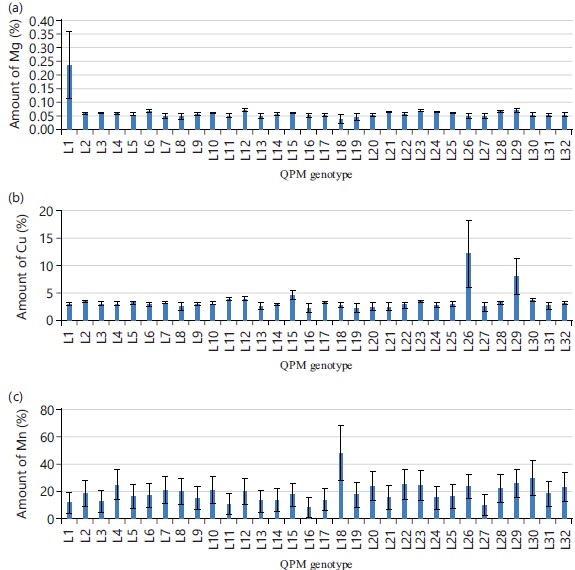
|
CONCLUSION
In the present study, the proportion of nutrients in maize cobs varied considerably at different levels of nitrogen application and the variation was not much among genotypes. The total digestible nutrient (TDN) in maize cobs was 76.19 with 1.64% of fat and 34.74% of starch at all nitrogen levels. The nitrogen application rate of 30N provided 17% of crude protein, 20% of crude fiber, 20% of ash, 0.11% of P, 0.2% of Ca, 0.07% of Mg, 180.63 mg kg–1 of Fe and 16.44 mg kg–1 of Mn. This rate of nitrogen application could be the most appropriate at the farmer level since it required less fertilizer application in maize production and the cobs could be efficiently used for different purposes. Maize cobs of genotypes L1, L7, L11, L13, L16, L8, L19, L21 and L27 contained a low amount of Mn, Cu and Mg elements and could be recommended for animal feeding and mushroom production while maize cobs for other genotypes could be used for compost and/or biochar production.
SIGNIFICANCE STATEMENT
The present research study provides an overview of the usefulness of Quality Protein Maize (QPM) cobs in animal feeding, crop production and soil fertility. The QPM cobs are crop residues that represent 17% of the total biomass in maize plants. Many farmers in the world do not make good use of maize cobs after harvesting. From the current study, it was found that the application of 30 kg ha–1 of nitrogen fertilizer could provide good QPM hybrids with optimum nutrient content in the cobs to ensure animal feeding, mushroom production and in some cases good quality of biochar for soil fertilization.
ACKNOWLEDGMENT
Acknowledgment is made to Dohne Research Institute for nutrient analysis and GMRDC at the University of Fort Hare (UFH) for financial support.
REFERENCES
- Li, M., H. Zhang, T. Xiao, S. Wang and B. Zhang et al., 2018. Low-cost biochar derived from corncob as oxygen reduction catalyst in air cathode microbial fuel cells. Electrochim. Acta, 283: 780-788.
- Jonathan, S.G., I.O. Fasidi, A.O. Ajayi and O. Adegeye, 2008. Biodegradation of Nigerian wood wastes by Pleurotus tuber-regium (Fries) Singer. Bioresour. Technol., 99: 807-811.
- Blandino, M., C. Fabbri, M. Soldano, C. Ferrero and A. Reyneri, 2016. The use of cobs, a by-product of maize grain, for energy production in anaerobic digestion. Ital. J. Agron., 11: 195-198.
- Latif, F. and M.I. Rajoka, 2001. Production of ethanol and xylitol from corn cobs by yeasts. Bioresour. Technol., 77: 57-63.
- Zhang, M., F. Wang, R. Su, W. Qi and Z. He, 2010. Ethanol production from high dry matter corncob using fed-batch simultaneous saccharification and fermentation after combined pretreatment. Bioresour. Technol., 101: 4959-4964.
- Kanengoni, A.T., M. Chimonyo, B.K. Ndimba and K. Dzama, 2015. Potential of using maize cobs in pig diets-A review. Asian Australas. J. Anim. Sci., 28: 1669-1679.
- Mierliţă, D., G. Sălăjan, B. Georgescu and A. Odagiu, 2001. The effects of corn cobs in feed. Acta Agraria Debreceniensis, 1: 51-54.
- Ndego, A., T. Ezedom, E.O. Egbune and N. Tonukari, 2023. Biochemical characterization of solid state fermented maize cob (Zea mays) using Rhizopus oligosporusand its application in poultry feed production. Int. J. Recycl. Org. Waste Agric., 12: 235-246.
- Itelima, J.U., 2012. Cultivation of mushroom (Pleurotus ostreatus) using corn cobs and saw dust as the major substrate. Global J. Agric. Sci., 11: 51-56.
- Adjapong, A.O., K.D. Ansah, F. Angfaarabung and H.O. Sintim, 2015. Maize residue as a viable substrate for farm scale cultivation of oyster mushroom (Pleurotus ostreatus). Adv. Agric., 2015: 213251.
- Ali, L., N. Manzoor, X. Li, M. Naveed and S.M. Nadeem et al., 2021. Impact of corn cob-derived biochar in altering soil quality, biochemical status and improving maize growth under drought stress. Agronomy, 11: 2300.
- Anukam, A.I., B.P. Goso, O.O. Okoh and S.N. Mamphweli, 2017. Studies on characterization of corn cob for application in a gasification process for energy production. J. Chem., 2017: 6478389.
- Woźniak, M., I. Ratajczak, D. Wojcieszak, A. Waśkiewicz and K. Szentner et al., 2021. Chemical and structural characterization of maize stover fractions in aspect of its possible applications. Materials, 14: 1527.
- Adeoluwa, O.O., C.S. Mutengwa, C. Chiduza and N.L. Tandzi, 2022. Nitrogen use efficiency of quality protein maize (Zea mays L.) genotypes. Agronomy, 12: 1118.
- Noelle, M.A.H., K. Richard, G. Vernon, Y.A. Martin, M.N. Laouali, T.N. Liliane and N.N. Godswill, 2017. Combining ability and gene action of tropical maize (Zea mays L.) inbred lines under low and high nitrogen conditions. J. Agric. Sci., 9: 222-235.
- Rawal, N., K.R. Pande, R. Shrestha and S.P. Vista, 2022. Accumulation of nitrogen, phosphorus, and potassium in various stages of hybrid maize (Zea mays L.) as affected by different levels of NPK in silty clay loam soil of nepal. Commun. Soil Sci. Plant Anal., 53: 1176-1195.
- Colmenero, J.J.O. and G.A. Broderick, 2006. Effect of dietary crude protein concentration on milk production and nitrogen utilization in lactating dairy cows. J. Dairy Sci., 89: 1704-1712.
- Halvorson, A.D. and J.M.F. Johnson, 2009. Corn cob characteristics in irrigated central great plains studies. Agron. J., 101: 390-399.
- Wachirapakorn, C., P. Parmaluk, M. Wanapat, P. Pakdee and A. Cherdthong, 2013. Effects of levels of crude protein and ground corn cobs in total mixed ration on intake, rumen fermentation and milk production in crossbred Holstein Friesian lactating dairy cows. J. Appl. Anim. Res., 42: 263-268.
- Le Gall, M., M. Warpechowski, Y. Jaguelin-Peyraud and J. Noblet, 2009. Influence of dietary fibre level and pelleting on the digestibility of energy and nutrients in growing pigs and adult sows. Animal, 3: 352-359.
- Urriola, P.E., G.C. Shurson and H.H. Stein, 2010. Digestibility of dietary fiber in distillers coproducts fed to growing pigs. J. Anim. Sci., 88: 2373-2381.
- Donkoh, A., E.K.D. Nyannor, A. Asafu-Adjaye and J. Duah, 2003. Ground maize cob as a dietary ingredient for broiler chickens in the tropics. J. Anim. Feed Sci., 12: 153-161.
- Nenova, L., M. Benkova, T. Simeonova and I. Atanassova, 2019. Nitrogen, phosphorus and potassium content in maize dry biomass under the effect of different levels of mineral fertilization. Agric. Sci. Technol., 11: 311-316.
- Christica, I.S. and R. Julia, 2018. Activated carbon utilization from corn cob (Zea mays) as a heavy metal adsorbent in industrial waste. Asian J. Pharm. Res. Dev., 6: 1-4.
- Olu, M., O.I. Olufade, O.O. Adekoyeni and M.O. Jimoh, 2013. Evaluation of heavy metal concentration in maize grown in selected industrial areas of Ogun State and its effects on urban food security. Int. J. Sci. Technol. Soc., 1: 48-56.
- Wienhold, B.J., G.E. Varvel and V.L. Jin, 2011. Corn cob residue carbon and nutrient dynamics during decomposition. Agron. J., 103: 1192-1197.
- Grzebisz, W., J.B. Diatta, J. Potarzycki, K. Przygocka-Cyna and W. Szczepaniak, 2010. Magnesium as a nutritional tool of nitrogen efficient management-plant production and environment. J. Elementol., 15: 771-788.
How to Cite this paper?
APA-7 Style
Liliane,
T.N., Olusola,
A.O., Charles,
M.S. (2023). Nutrients Availability in Quality Protein Maize (QPM) Cobs at Various Levels of Nitrogen Application. Trends in Applied Sciences Research, 18(1), 29-40. https://doi.org/10.3923/tasr.2023.29.40
ACS Style
Liliane,
T.N.; Olusola,
A.O.; Charles,
M.S. Nutrients Availability in Quality Protein Maize (QPM) Cobs at Various Levels of Nitrogen Application. Trends Appl. Sci. Res 2023, 18, 29-40. https://doi.org/10.3923/tasr.2023.29.40
AMA Style
Liliane
TN, Olusola
AO, Charles
MS. Nutrients Availability in Quality Protein Maize (QPM) Cobs at Various Levels of Nitrogen Application. Trends in Applied Sciences Research. 2023; 18(1): 29-40. https://doi.org/10.3923/tasr.2023.29.40
Chicago/Turabian Style
Liliane, Tandzi, Ngoune, Adeoluwa Oluyinka Olusola, and Mutengwa Shelton Charles.
2023. "Nutrients Availability in Quality Protein Maize (QPM) Cobs at Various Levels of Nitrogen Application" Trends in Applied Sciences Research 18, no. 1: 29-40. https://doi.org/10.3923/tasr.2023.29.40

This work is licensed under a Creative Commons Attribution 4.0 International License.



